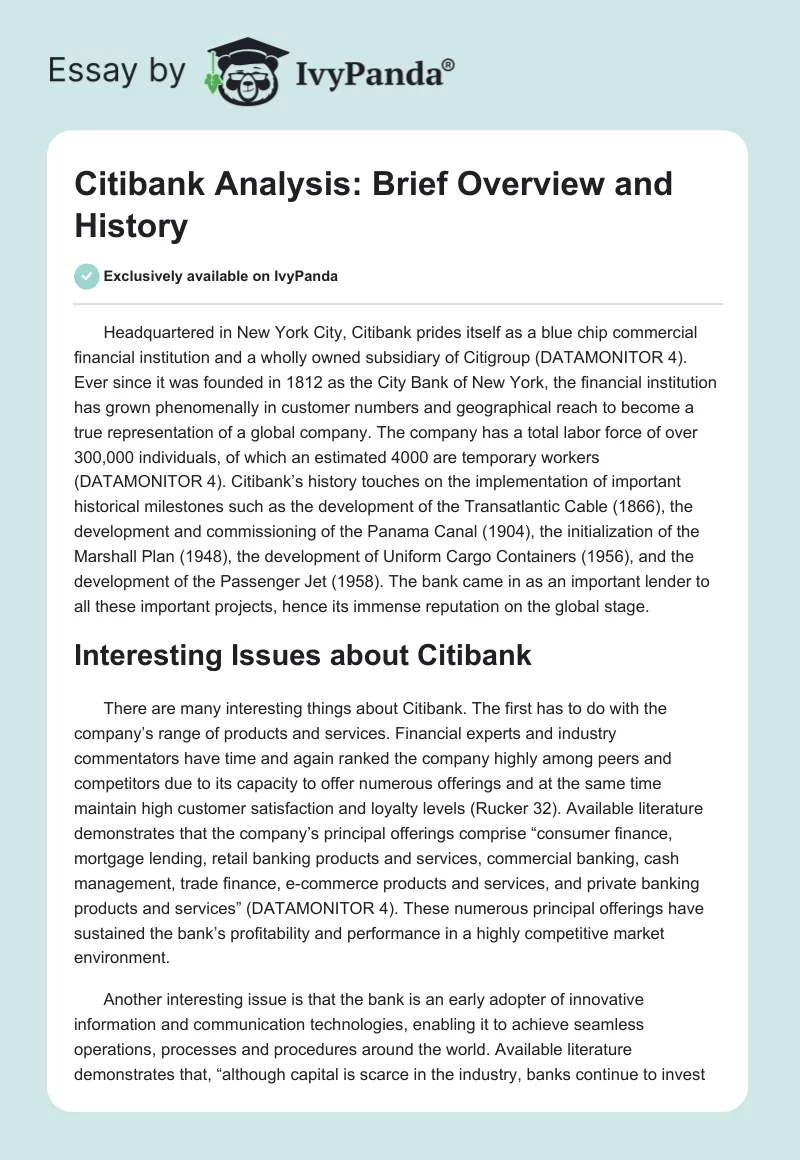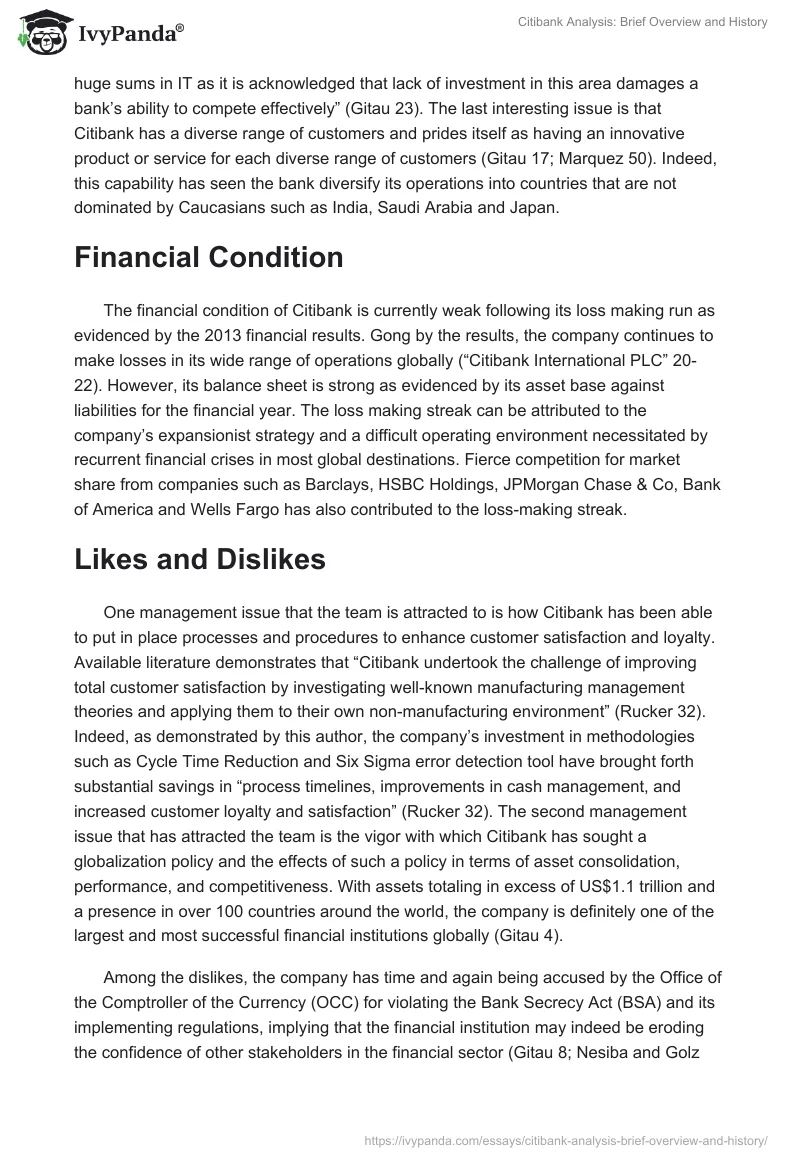Headquartered in New York City, Citibank prides itself as a blue chip commercial financial institution and a wholly owned subsidiary of Citigroup (DATAMONITOR 4). Ever since it was founded in 1812 as the City Bank of New York, the financial institution has grown phenomenally in customer numbers and geographical reach to become a true representation of a global company. The company has a total labor force of over 300,000 individuals, of which an estimated 4000 are temporary workers (DATAMONITOR 4). Citibank’s history touches on the implementation of important historical milestones such as the development of the Transatlantic Cable (1866), the development and commissioning of the Panama Canal (1904), the initialization of the Marshall Plan (1948), the development of Uniform Cargo Containers (1956), and the development of the Passenger Jet (1958). The bank came in as an important lender to all these important projects, hence its immense reputation on the global stage.
Interesting Issues about Citibank
There are many interesting things about Citibank. The first has to do with the company’s range of products and services. Financial experts and industry commentators have time and again ranked the company highly among peers and competitors due to its capacity to offer numerous offerings and at the same time maintain high customer satisfaction and loyalty levels (Rucker 32). Available literature demonstrates that the company’s principal offerings comprise “consumer finance, mortgage lending, retail banking products and services, commercial banking, cash management, trade finance, e-commerce products and services, and private banking products and services” (DATAMONITOR 4). These numerous principal offerings have sustained the bank’s profitability and performance in a highly competitive market environment.
Another interesting issue is that the bank is an early adopter of innovative information and communication technologies, enabling it to achieve seamless operations, processes and procedures around the world. Available literature demonstrates that, “although capital is scarce in the industry, banks continue to invest huge sums in IT as it is acknowledged that lack of investment in this area damages a bank’s ability to compete effectively” (Gitau 23). The last interesting issue is that Citibank has a diverse range of customers and prides itself as having an innovative product or service for each diverse range of customers (Gitau 17; Marquez 50). Indeed, this capability has seen the bank diversify its operations into countries that are not dominated by Caucasians such as India, Saudi Arabia and Japan.
Financial Condition
The financial condition of Citibank is currently weak following its loss making run as evidenced by the 2013 financial results. Gong by the results, the company continues to make losses in its wide range of operations globally (“Citibank International PLC” 20-22). However, its balance sheet is strong as evidenced by its asset base against liabilities for the financial year. The loss making streak can be attributed to the company’s expansionist strategy and a difficult operating environment necessitated by recurrent financial crises in most global destinations. Fierce competition for market share from companies such as Barclays, HSBC Holdings, JPMorgan Chase & Co, Bank of America and Wells Fargo has also contributed to the loss-making streak.
Likes and Dislikes
One management issue that the team is attracted to is how Citibank has been able to put in place processes and procedures to enhance customer satisfaction and loyalty. Available literature demonstrates that “Citibank undertook the challenge of improving total customer satisfaction by investigating well-known manufacturing management theories and applying them to their own non-manufacturing environment” (Rucker 32). Indeed, as demonstrated by this author, the company’s investment in methodologies such as Cycle Time Reduction and Six Sigma error detection tool have brought forth substantial savings in “process timelines, improvements in cash management, and increased customer loyalty and satisfaction” (Rucker 32). The second management issue that has attracted the team is the vigor with which Citibank has sought a globalization policy and the effects of such a policy in terms of asset consolidation, performance, and competitiveness. With assets totaling in excess of US$1.1 trillion and a presence in over 100 countries around the world, the company is definitely one of the largest and most successful financial institutions globally (Gitau 4).
Among the dislikes, the company has time and again being accused by the Office of the Comptroller of the Currency (OCC) for violating the Bank Secrecy Act (BSA) and its implementing regulations, implying that the financial institution may indeed be eroding the confidence of other stakeholders in the financial sector (Gitau 8; Nesiba and Golz 37) The company needs to take wide-ranging corrective actions to enhance its BSA compliance program, which in turn will improve the confidence of customers and other stakeholders in the banking industry. The second dislike is that, compared to most of its peers, the bank suffers from low credit rating due to high rates of loans default, subsequent huge provisions for loans losses, and other practices that seem to adversely affect its financial reputation (DATAMONITOR 6). It should be recalled that bank was bailed out by the U.S. government during the 2008/2009 financial crisis. The low credit rating, according to this documentation, continues to affect its liquidity position in a negative way.
Conclusion
This paper has carefully demonstrated some of the most strategic information about Citibank, from its humble beginnings in 1812 to where the bank has reached now. It is our believe that the information provided will serve as an eye opener to potential customers and investors, particularly in terms of understanding why Citibank is still considered the leading global bank despite its loss-making streak.
Works Cited
Citibank International PLC 2013. Web.
DATAMONITOR 2009. Citibank, NA: Company Profile. Web.
Gitau, Phoebe 2009. Strategic Responses by Citibank Limited to External Environmental Challenges. Web.
Marquez, Jessica. “Leading Indicators.” Workforce Management. 84.7 (2005): 49-52. MasterFILE Premier. Web.
Nesiba, Reynold F. and Nathan Golz. “Sioux Falls, Citibank, and CRA: Do US Credit Card Banks Deserve their Outsourcing Community Reinvestment Performance Evaluations?” Journal of Economic Issues. 36.2 (2002): 485-493. Business Source Elite. Web.
Rucker, Rochelle. “Citibank Increases Customer Loyalty with Defect-Free Processes.” Journal for Quality & Participation. 23.4 (2000): 32-36. Business Source Elite. Web.


